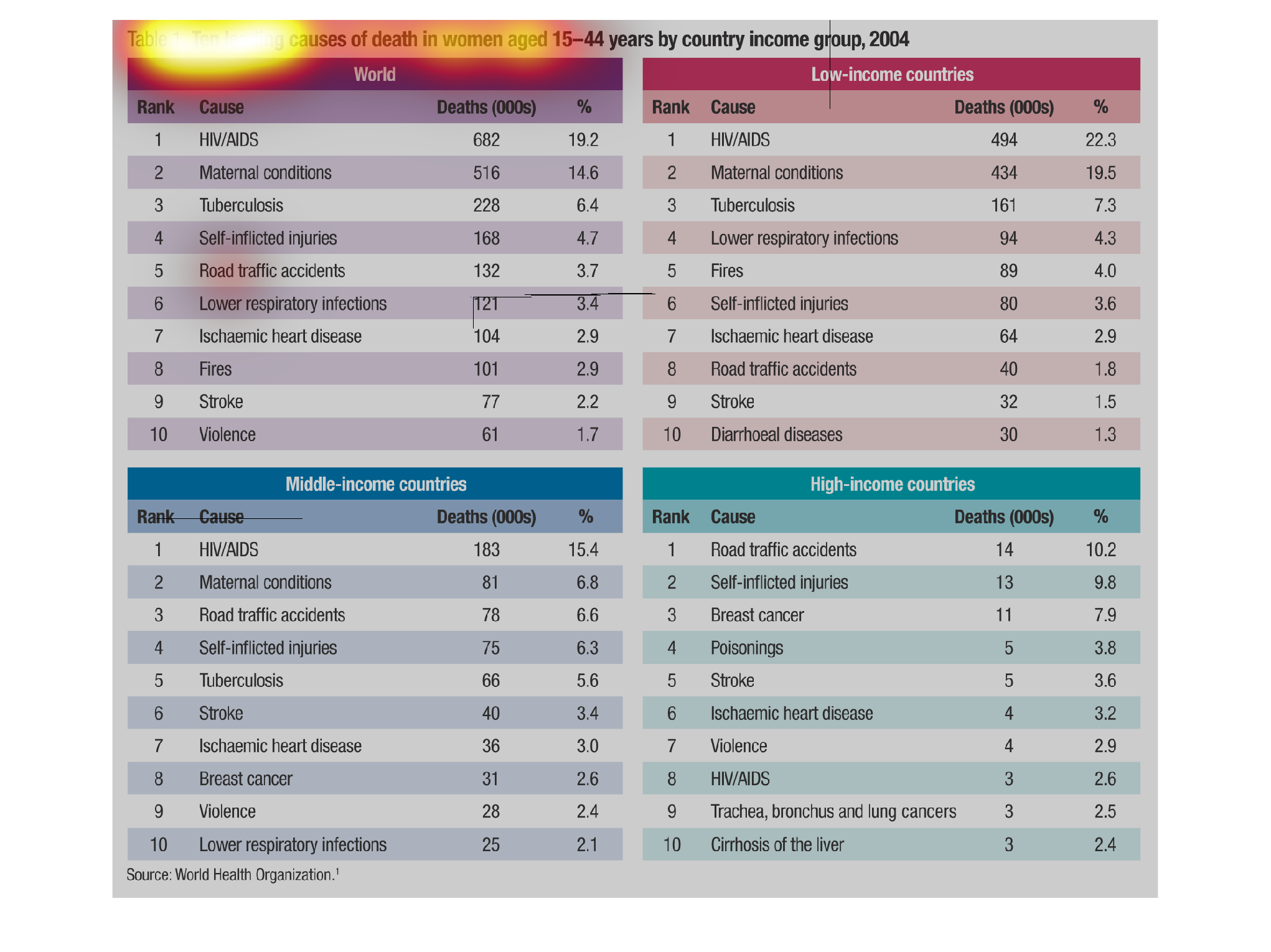
10 leading causes of death in women ages 15-44 2004 lower income countries suffer much more
from diseases such as aids, tuberculosis, and maternal death, where higher income countries
are more traffic accidents, suicide, cancer etc


This figure is titled Ten leading causes of death in women aged 15-44 years by country income
group, 2004. The figure has four different groups to sort the data into.


This is a chart with four tables. Table one lists the top 10 causes of death in 2004 for
women around the world. The other three tables list the top 10 causes of death in low income
countries, middle income, and high income. The tables each have different colors to identify
them, the colors being purple, pink, blue, and aqua.


This image shows the leading causes of death in adult women in low, middle, and high income
countries in the 2000s. It appears that in middle and low income countries, HIV/AIDS is the
leading cause of death, whereas in high income countries road accidents are.


The spreadsheet shows the ten leading causes of death of women between the ages of 15 - 44
by country and income group from 2004. The highest are HIV/AIDS, 682,000, which is 19.2%
of the population in the world. In low-income countries, HIV/AIDS, 494,000, which is 22.3%
of the population in low-income countries. In middle income countries, the numbers decrease
as HIV/AIDS is still the leading cause of death. There are 183,000 deaths which is 15.4%
of the population and in high-income countries, road traffic accidents account for 14,000
deaths which is 10.2% of the population.


This table lists the ten leading causes of death in women aged 15-44, arranged by country
and income. Worldwide, AIDS kills by far the greatest numbers of women of childbearing age.
In high income countries there are far fewer death and they are mostly due to car accidents.


This is a table made from data collected in 2004 that shows the 10 leading causes of death
in women aged 15-44 by the income group of their country. The first table on the upper left
(in purple) shows the 10 leading causes of death in women aged 15-44 worldwide. The other
graphs show the leading causes of death for this cohort of women based on the income level
of their country (low-income, middle-income, or high-income). The main trend I see is that
the leading causes of death are very different based on income. Women from lower-income countries
are dying more because of preventable and curable diseases and accidents where women from
higher-income countries are dying more from chronic diseases and accidents.


Table showing the leading causes of death in women aged 15-44 years by country income group,
2004. Divided up by leading causes in the world (#1 HIV/AIDS), in low-income countries (#1
HIV/AIDS), middle-income countries (#1 HIV/AIDS), and high-income countries (#1 Road traffic
accidents).


The following chart shows the leading cause of death from women ages 15-44. The countries
are divided into groups based on Low Income, Middle Income and High Income Countries.


This graph shows the ten leading cause of death in women aged 15-44 years by country income
group. The groups are: world, low income countries, middle income countries, and high income
countries. The ten leading causes are ranked with rank one being the cause of the most deaths.


This chart describes ten leading causes of death in women aged 15-44 years by country income
group, for the year 2004. Causes of death include HIV/Aids.


This image breaks up the deaths of women from the ages 15 to 44 by the income level of their
country as well as by type of death. The wealth of a country does seem to have a real impact.


This is a chart from 2004 showing the ten leading causes of death in women ages 15-44 years
old by country income group. It shows comparisons between the world, high income, middle income,
and low income classes. HIV aids is the top cause in three categories.


This is a series of tables depicting the ten leading causes of death in women aged 15-44 years
old by country and separates them by income group in the year 2004.






























